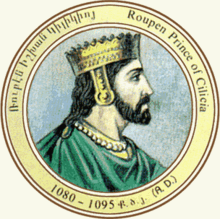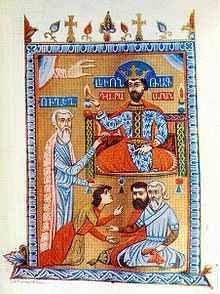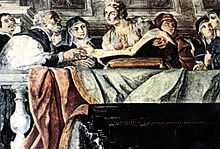List of Armenian kings
This is a list of the kings and queens of Armenia, for more information on ancient Armenia and Armenians, please see History of Armenia. For information on the medieval Armenian Kingdom in Cilicia, please see the separate page Armenian Kingdom of Cilicia.
See List of Kings of Urartu for kings of Urartu (Ararat), the predecessor state of Greater Armenia.
Greater Armenia
This is the historical designation of the largest and longest-lasting Armenian kingdom.
Orontid Kings and Satraps
In Armenian tradition
Early kings in traditional Armenian chronology according to Moses of Chorene.
Note that the early dates are traditional and of uncertain accuracy.
- Orontes I Sakavakyats (570-560 BC)
- Tigranes Orontid (560-535 BC)
- Vahagn (530-515 BC)
- Hidarnes I (late 6th century BC)
- Hidarnes II (early 5th century BC)
- Hidarnes III (middle of the 5th century BC)
- Ardashir (2nd half of the 5th century BC)
Attested satraps
- Orontes (401-344 BC)
- Darius Codomannus (344-336 BC)
Yervandian (Yervanduni or Orontid) Dynasty
- Orontes II (336-331 BC)
- Mithranes (331-323 BC)
- Perdiccas (non-dynastic) (323 BC)
- Neoptolemus Orontid (non-dynastic) (323-321 BC)
- Eumenes (non-dynastic) (321 BC)
- Mithranes (321-317 BC)
- Orontes III (317-260 BC)
- Sames (260-243 BC)
- Arsames (243-228 BC)
- Xerxes (228-212 BC)
- Orontes IV (212–200 BC)
- Abdisares ( 189-166 BC)
Artashesian (Artaxiad) Dynasty
- Artaxias I (190 BC-159)
- Tigranes I (159 BC-123)
- Artavasdes I (123 BC-95)
- Tigranes the Great (Tigranes II, 95 BC-55)
- Artavasdes II (55 BC-34)
- Artaxias II (33 BC-20)
- Tigranes III (20 BC-10)
- Tigranes IV with Erato (10 BC-2 BC)
Roman and Parthian non-dynastic candidates
- Ariobarzanes, 2 BC to 4 (Roman protectorate)
- Artavasdes III 4 to 6
- Tigranes V, 6 then ruled with Erato from 6-12
- Vonones (former king of Parthia) 12-16 (Roman protectorate)
- Roman interregnum 16-18 (Vonones as nominal king)
- Artaxias III 18-35 (Roman protectorate)
- Arsaces I of Armenia (son of Artabanus III) 35 (Parthian protectorate)
- Orodes of Armenia (pretender, son of Artabanus III) 35
- Mithridates 35-37 (Roman protectorate)
- Orodes (now king) 37-42 (Parthian protectorate)
- Mithridates (second time) 42-51 (Roman protectorate)
- Rhadamistus (son of Pharasmanes I of Iberia) 51-53 (Roman protectorate)
- Tiridates I (son of Vonones II of Parthia) 53 (Roman protectorate)
- Rhadamistus (second time) 53-54 (Roman protectorate)
Arshakuni (Arsacid) Kings of Armenia
- Tiridates I (second time) 52-58
- Tigranes VI 59-62 (Roman protectorate)
- Tiridates I 62-88 (Parthian protectorate 62-63; from 63 Armenia again becomes a Roman protectorate)
- Sanatruces (Sanatruk) 88-110
- Axidares (Ashkhadar) 110–113
- Parthamasiris (Partamasir) 113–114
- Roman Province 114–117/8
- Vologases I (Vagharsh I) 117/8–144
- Sohaemus 144-161
- Bakur 161–164
- Sohaemus (second time) 163/4-186?
- Vologases II (Vagharsh II) 186–198
- Khosrov I 198–217
- Tiridates II 217-252
- Khosrov II c. 252
- Sassanid Occupation 252-287
- Artavasdes IV 252-287 Sassanid Client King
- Tiridates III 287-330 (Roman protectorate again)
- Khosrov III 330–339
- Tigranes VII (Tiran) 339 - c. 350
- Arsaces II (Arshak II) c. 350–368
- Sassanid Occupation 368
- Papas (Pap) 370-374
- Varasdates (Varazdat) 374–378
- Arsaces III (Arshak III) 378–387 with co-ruler Vologases III (Vagharsh III) 378-386
- Khosrov IV 387–389
- Vramshapuh 389–417
- Local Independent Government 417-422
- Artaxias IV (Artashir IV) 422–428
Marzpanate
- Veh Mihr Shapur 428-442
Vasak, king of Siunik 442-451
Vartan Mamikonian[AKA Vartan Zoravar, legendary Armenian general killed in battle but preserved Armenia as first Christian nation in the world]
- Adhur Hormizd (Adrormizd) 451-465
- Adhur Gushnasp (Ardervechnasp) 465-481
- Sahak Bagratuni 481-482
Military occupation by General Mihran 482
- Vahan Mamikonian (provisional) 482-483
- Zarmihr Karen (military occupation) 483
- Shapur of Ray 483-484
- Vahan Mamikonian (second time) 484-505/510 (provisional government 484-485)
- Vard Mamikonian (brother) 505/510-509/514
- Gushnasp Vahram ? 509/514-518
- Mjej Gnuni 518-548
- Tan-Shapur 548-552
- Gushnasp Vahram (second time?) 552-554
- Tan-Shapur (second time) 554-558/60
- Varazdat 558/560-564
- Sunen 564-572
- Tamkhosrau 577-580
- Varaz Vzur 580-581
- Aspahbad Pahlav 581-582/588
- Frahat 582/588-588/589
- Hratzin 588/589-590
- To Byzantium 590
- Musel Mamikonian 590-591 (governor)
- Hamarakar 591 (governor)
- Unknown 591-603 (governors)
- Smbat IV Bagratuni 603-611
- Shahrayanpet (in the East) 611-613
- Shahin Vahmanzadaghan (in the West) 611-613
- Parsayenpet 613-616
- Namdar Gushnasp 616-619
- Shahraplakan (Sarablagas) 619-624
- Rozbihan 624-627
- Byzantine province 627-628
- Varaztirots Bagratuni 628-634
- Unknown 634-?
- Mjej Gnuni 627-635
- Vahan 636
- Davith Saharuni 636-638
- Several "nakharar" 638-643
- Theodore Rshtuni 643-645
- Varaztirots Bagratuni 645-646
Presiding Princes of Armenia
- Theodore Rshtuni 646-653
- Smbat I Bagratuni 646-653 (together Theodoros, in 753 alone)
- Theodore Rshtuni (second time) 653-654
- Musel Mamikonian 654
- Maurianos 654
- Theodore Rshtuni (third time) 654-655
- Maurianos (second time) 655
- Theodore Rshtuni (fourth time) 655
- Hamazasp Mamikonian 655-661
- Grigor Mamikonian 661-685
- Ashot Bagratuni 685-690
- Nerseh Kamsarakan 690-693
- Smbat II Bagratuni (son of Varaztirots Bagratuni) 693-695 (Muslim protectorate)
- Abd Allah ibn Hatim al-Bahili 695-696
- Smbat II Bagratuni (second time) 696-705 (independent)
- To Umayyad Caliphate 705
- Ashot III Bagratuni the Blind 732-745
- Grigor Mamikonian 745-746
- Ashot III Bagratuni the Blind (second time) 746-750
- Grigor Mamakonian (second time) 750-751
- Musel Mamikonian (brother of Grigor) 751-?
- Arab occupation 751-754
- Sahak Bagratuni, lord of Taron 754-771
- Smbat Bagratuni 771-772
- vacant 772-781
- Tachat Andzevatsi 781-785
- vacant 785-806
Bagratuni Kings
- Ashot I the Great, 885-890
- Smbat I the Martyr, 890-914
- Ashot II the Iron, 914-928
- Abas I of Armenia, 928-952
- Ashot III the Merciful, 952-977
- Smbat II the Conqueror, 977-989
- Gagik I, 989-1020
- Hovhannes-Smbat of Ani - Hovhannes [John]-Smbat III (XI) (son), 1020–1040
- Ashot IV the Valiant, 1021–1039 (concurrently in certain regions after rebellion against Hovhannes-Smbat)
- Gagik II, 1042–1045, dies c. 1079
Armenian Kingdom of Cilicia
Lords/Princes
| Name |
Lifespan |
Reign start |
Reign end |
Notes |
Family |
Image |
| Ruben I
|
1080 | 1095 | Rubenids |  |
||
| Constantine I
|
1095 | 1102 | Rubenids | |||
| Thoros I
|
1102 | 1129 | Rubenids | |||
| Constantine II
|
1129 | 1129 | Rubenids | |||
| Leo I
|
1129 | 1140 | Rubenids | |||
| Thoros II
|
1144 | 1169 | Rubenids | |||
| Ruben II
|
1169 | 1170 | Rubenids | |||
| Mleh
|
1170 | 1175 | Rubenids | |||
| Ruben III
|
1175 | 1187 | Rubenids | |||
| Leo II
|
1187 | 1198/1199 | Became first king as Leo I | Rubenids |  |
Kings and Queens
| Name |
Lifespan |
Reign start |
Reign end |
Notes |
Family |
Image |
| Leo II
|
1198/1199 | 1219 | Rubenids |  |
||
| Isabella
|
1219 | 1252 | Queen and co-ruler | Rubenids |  |
|
| Hethum I
|
1226 | 1270 | Co-ruler | Hethumids |  |
|
| Leo III
|
1270 | 1289 | Hethumids |  |
||
| Hethum II
|
1289 | 1293 | Abdicated in favour of Thoros III | Hethumids |  |
|
| Thoros III
|
1293 | 1298 | Recalled Hethoum II, with whom he became co-ruler | Hethumids | ||
| Hethum II
|
1295 | 1296 | Co-ruler with Thoros III | Hethumids |  |
|
| Sempad
|
1296 | 1298 | Usurper | Hethumids | ||
| Constantine III
|
1298 | 1299 | Hethumids | |||
| Hethum II
|
1299 | 1303 | Reclaimed throne. Abdicated and became regent for Leo III | Hethumids |  |
|
| Leo IV
|
1303 | 1307 | Under regency of Hethum II | Hethumids | ||
| Oshin
|
1307 | 1320 | Hethumids | |||
| Leo V
|
1320 | 1341 | Under regency of Oshin of Korikos until 1329 | Hethumids |  |
|
| Constantine IV
|
1342 | 1344 | Elected by nobles | Lusignan | ||
| Constantine V
|
1344 | 1362 | House of Neghir |  |
||
| Constantine VI
|
1362 | 1373 | House of Neghir or Lusignan | |||
| Leo VI
|
1374 | 1375 | Lusignan |  |
Claimants
| Name |
Lifespan |
Reign start |
Reign end |
Notes |
Family |
Image |
| Leo VI
|
1375 | 1393 | Lusignan |  |
||
| James I
|
1396 | 1398 | Lusignan | |||
| Janus
|
1398 | 1432 | Lusignan | |||
| John
|
1432 | 1458 | Lusignan | |||
| Charlotte
|
1458 | 1467 | Lusignan |  |
The title passed to the branch of the Lusignans in Constantinople and eventually Russia. The title is contested by the House of Savoy.
References
- General
- Boase, T. S. R. (1978). The Cilician Kingdom of Armenia. Edinburgh: Scottish Academic Press. ISBN 0-7073-0145-9.
- Mutafian, Claude (2001). Le Royaume Arménien de Cilicie. Paris: CNRS Editions. ISBN 2-271-05105-3.
- Histoire Des Princes de Lusignan, Anciens Rois de Jérusalem, de la Petite Arménie et de Chypre, St.Petersbourg, Soikine, Stremiannaya 12, 1903